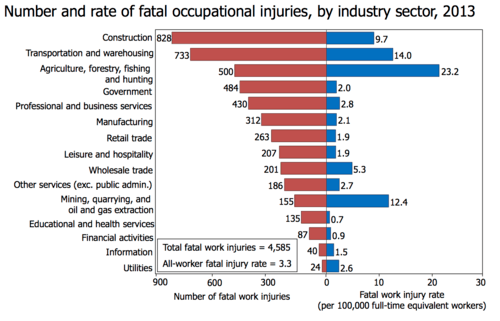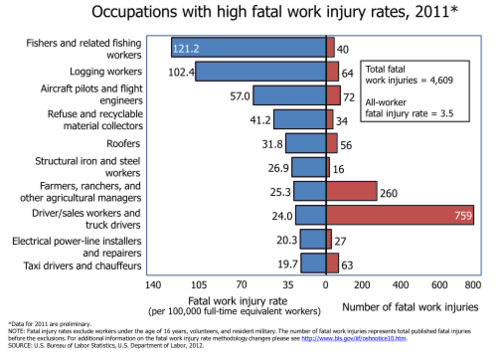Occupational fatality
An occupational fatality is a death that occurs while a person is at work or performing work related tasks. Occupational fatalities are also commonly called “occupational deaths” or “work-related deaths/fatalities” and can occur in any industry or occupation.
Common causes
Common causes of occupational fatalities include falls, machine-related incidents, motor vehicle accidents, electrocution, falling objects, homicides and suicides. Oftentimes, occupational fatalities can be prevented.
In the United States in 2007, 42% of occupational fatalities occurred during a transportation incident, 16% occurred after a worker came into contact with an object or equipment, 15% occurred as a result of a fall, 15% occurred as a result of assault or other violent acts in the workplace, 12% were the result of chemical or environmental exposures (9%) and 3% were the result of fires or explosions.[1]
 Number and rate of fatal occupational injuries, by industry sector, 2013 in the United States.[2]  Selected occupations with high fatality rates, 2011, in the United States.[2] |
Risk factors
Many factors contribute to a fatal incident at work. Lack of appropriate employee training and failure to provide and enforce the use of safety equipment are frequent contributors to occupational fatalities. In some cases, employees do receive safety training, but language barriers prevent the employee from fully understanding the safety procedures. Incidents can also be the result of insufficient supervision of inexperienced employees or employees who have taken on a responsibility for which they are not properly trained. Poor worksite organization, staffing and scheduling issues, unworkable policies and practices and workplace culture can all play a role in occupational fatalities. An incident leading to an occupational fatality is generally not the fault of a single person, but the result of a combination of many human and environmental factors.
Demographics
In distinction to "risk factors", which may be thought to imply a causal link between such factors and fatality, statistics such as those from the U.S. Bureau of Labor Statistics on the demographics of deaths at work do not imply that age and gender are in themselves causative factors of fatality, but simply show that fatalities occur more frequently among certain groups.
Age
Although all workers are at risk for occupational fatalities, elderly workers age 65 and older are roughly three times more likely to die at work.[3]
Gender
A large majority of occupational deaths occur among men. In one U.S. study, 93% of deaths on the job involved men,[4] with a death rate approximately 11 times higher than women. The industries with the highest death rates are mining, agriculture, forestry, fishing, and construction, all of which employ more men than women.[5] Deaths of members in the military is currently above 90% men.[6]
Prevention
Occupational fatalities are preventable. Prevention of occupational fatalities depends on the understanding that worker safety is not only the responsibility of the worker, but is the primary responsibility of the employer. Employers must train all employees in the appropriate safety procedures and maintain a safe working environment so that fatalities are less likely to occur.[7] An occupational fatality is not just the fault of the deceased worker; instead, it is the combination of unsafe work environments, insufficient safety training, and negligible employee supervision that contribute fatal incidents. As a result, it is imperative that an employer address all the potential [risk] factors at the workplace and educate all employees in safe work practices and risk awareness.
In order to perform adequate risk assessment of injuries that occur in the workplace, health and safety professionals use resources such as the Haddon Matrix. This model assesses the risks leading up to, during, and after a death in order to prevent future incidents of a similar nature. Employers and employees can learn how to identify risk factors in their work environment in order to avoid incidents that may result in death.
Research, regulation, reporting and recommendations
The regulatory organization for occupational injury control and prevention is the Occupational Safety and Health Administration (OSHA). Formed in 1970 as an agency of the United States Department of Labor under the Occupational Safety and Health Act, OSHA exists to prevent occupational injuries and deaths by creating and enforcing standards in the workplace. OSHA standards address employee training programs, safety equipment, employer record keeping and proper maintenance of the work environment. Failure to comply with the OSHA standards can result in workplace inspections and legal action including citations and fines. In very severe cases of employer misconduct, OSHA can “red flag” an operation and send the employer to legal court.[8]
To regulate the millions of workplaces in the United States, OSHA requires that all employers maintain a record of occupational injuries, illnesses and fatalities. Occupational fatalities must be reported to OSHA within eight hours of the incident. Failure to do so can result in legal action against the employer. Employers are responsible for staying current on OSHA standards and enforcing them in their own workplace. State OSHA organizations exist in twenty-eight states and are required to have the same or more rigorous standards than the federal OSHA standards. In these states, employers must abide by their state’s regulations. It is not the responsibility of the employee to stay current on the OSHA standards.
In addition to OSHA, the National Institute for Occupational Safety and Health (NIOSH) was formed under the Occupational Safety and Health Act as a federal research agency to formulate industry recommendations for health and safety. NIOSH is part of the Centers for Disease Control and Prevention (CDC) in the United States Department of Health and Human Services (DHHS). NIOSH analyzes workplace injury and illness data from all fifty states as well as provides support for state-based projects in occupational health and safety.
Under NIOSH, the Fatality Assessment and Control Evaluation (FACE) Program tracks and investigates occupational fatalities in order to provide recommendations for prevention. A voluntary program for individual states created in 1989, FACE is active in California, Iowa, Kentucky, Massachusetts, Michigan, New Jersey, New York, Oregon, and Washington. The primary responsibilities of the state FACE programs are to track occupational fatalities in their state, investigate select fatalities, and provide recommendations for prevention. As part of the prevention efforts, FACE programs also produce extensive prevention education materials that are disseminated to employees, employers, unions, and state organizations.
Nationally, the Census of Fatal Occupational Injuries (CFOI), within the U.S. Department of Labor, compiles national fatality statistics. CFOI is the key, comprehensive system in the surveillance of occupational fatalities in the United States.
Many other non-governmental organizations also work to prevent occupational fatalities. Trade associations and unions play an active role in protecting workers and disseminating prevention information. The National Safety Council also works to prevent occupational fatalities as well as provide resources to employers and employees.
References
- ↑ "Census of Fatal Occupational Injuries Charts 1992-2007" (PDF). U.S. Department of Labor, Bureau of Labor Statistics. 2009. p. 4.
- 1 2 Bureau of Labor Statistics; NATIONAL CENSUS OF FATAL OCCUPATIONAL INJURIES IN 2006
- ↑ “Census of Fatal Occupational Injuries Summary Report 2007.” http://www.bls.gov/news.release/cfoi.nr0.htm. Census of Fatal Occupational Injuries
- ↑ "Census of Fatal Occupational Injuries Summary, 2013". Bureau of Labor Statistics. United States Department of Labor. 11 September 2014. Retrieved March 2015. Check date values in:
|accessdate=(help) - ↑ Fatal Occupational Injuries - United States, 1980-1997 MMWR Weekly, April 27, 2001
- ↑ DeBruyne, Nese (April 26, 2017). "American War and Military Operations Casualties: Lists and Statistics" (PDF). Federation Of American Scientists Logo. Retrieved August 8, 2017.
- ↑ "Health and Safety Act 1970 – Section 5 Duties." https://www.osha.gov/pls/oshaweb/owasrch.search_form?p_doc_type=OSHACT&p_toc_level=0&p_keyvalue=&p_status=CURRENT. Retrieved 17 February 2009
- ↑ "Health and Safety Act 1970 – Section 17 Penalties." https://www.osha.gov/pls/oshaweb/owasrch.search_form?p_doc_type=OSHACT&p_toc_level=0&p_keyvalue=&p_status=CURRENT. Retrieved 17 February 2009
External links
- World Health Organization Occupational Health Programmes
- International Labour Organization
- British Health and Safety Executive
- Canadian Centre for Occupational Health and Safety
- Australian Safety and Compensation Council
- USA Occupational Safety and Health Administration (OSHA)
- USA National Institute for Occupational Safety and Health (NIOSH)
- USA Fatality Assessment and Control Evaluation (FACE) Program
- Washington State Fatality Assessment and Control Evaluation (WA FACE) Program
- USA Census of Fatal Occupational Injury (CFOI)
- National Safety Council
- AFL-CIO
- California Fatality Assessment and Control Evaluation Program (CA FACE)